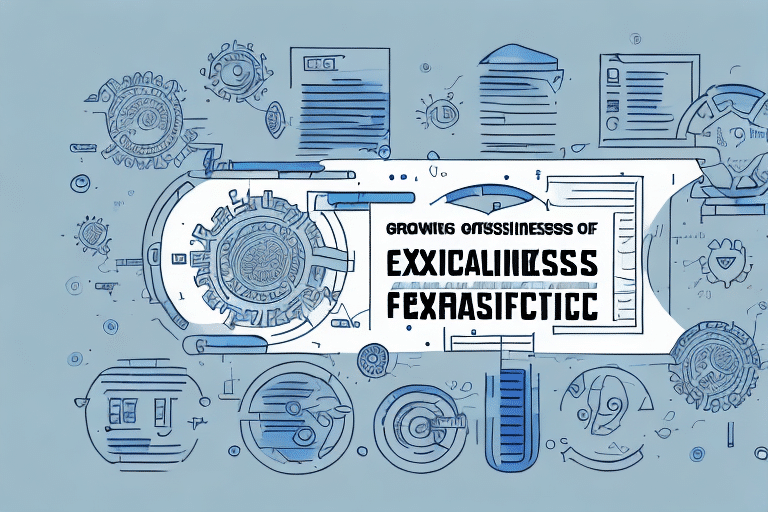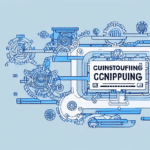How to Maintain Operational Efficiency During Rapid Growth
Maintaining operational efficiency is critical for any business, especially during times of rapid growth. As a company expands, its business processes become more complex and require more resources to manage. However, failure to maintain efficiency can lead to increased costs, decreased productivity, and ultimately, the failure of the business. In this article, we will explore the importance of operational efficiency, how to identify and prioritize key business processes, streamline operations, hire the right people, implement effective performance management systems, utilize technology, monitor key metrics, create a culture of efficiency and continuous improvement, overcome common challenges, and balance growth with efficiency.
Why Operational Efficiency is Important During Rapid Growth
Operational efficiency is the ability to produce goods or provide services with minimal waste of time, effort, or resources. During rapid growth, maintaining operational efficiency ensures that businesses can keep up with demand and optimize profits. According to a [Harvard Business Review](https://hbr.org/), companies that prioritize operational efficiency are 30% more likely to sustain long-term growth.
Failure to maintain efficiency can lead to decreased productivity, increased costs, and ultimately, the downfall of the business. Additionally, operational efficiency provides a competitive advantage, enabling businesses to adapt more quickly to market changes.
Implementing automation and technology solutions is one effective way to enhance operational efficiency. These solutions streamline processes, reduce errors, and allow employees to focus on higher-level tasks. For example, investing in inventory management software can significantly decrease the time and effort required to track and order supplies.
Effective communication and collaboration are also vital. As a business grows, coordination across different departments becomes more complex. Utilizing collaboration tools like [Slack](https://slack.com/) or [Microsoft Teams](https://www.microsoft.com/en-us/microsoft-teams/group-chat-software) can help ensure that all team members are aligned and working towards common goals.
Identify Your Key Business Processes and Prioritize Them
The first step in maintaining efficiency during rapid growth is to identify and prioritize your key business processes. This involves analyzing all company operations to determine which are critical for success. Tools like [Business Process Mapping](https://www.lucidchart.com/pages/business-process-mapping) can help visualize and assess these processes.
Once key processes are identified, prioritize them based on their importance and allocate resources accordingly. This ensures that critical tasks receive the necessary attention and resources, while non-essential tasks are streamlined or automated.
Regularly review and update your prioritization as your company grows and evolves. New challenges and opportunities may shift the importance of certain processes, requiring continuous reassessment to ensure optimal resource allocation.
Streamline Your Operations by Automating Repetitive Tasks
Automating repetitive tasks is one of the most effective ways to maintain operational efficiency. Identify tasks that are time-consuming, repetitive, and prone to error, and implement technology to handle them. Automation not only saves time and reduces errors but also frees up resources for more strategic activities.
For example, using [Zapier](https://zapier.com/) to automate data entry between applications can significantly reduce manual work and decrease the likelihood of errors.
Additionally, automation can enhance employee satisfaction by eliminating mundane tasks, allowing employees to engage in more meaningful and fulfilling work. This can lead to increased job satisfaction, higher productivity, and reduced turnover rates.
Automation also improves data accuracy and consistency. By automating data entry and processing, businesses can ensure that information is consistently recorded across different systems, leading to better decision-making and more accurate reporting.
Hire the Right People for the Job to Ensure Efficiency
Hiring the right people is crucial for maintaining operational efficiency. Identify the skills and experience necessary for each role and select candidates who possess them. Beyond technical skills, consider cultural fit and a candidate’s commitment to continuous learning and improvement.
Providing comprehensive training and development opportunities is essential. This includes on-the-job training, mentorship programs, and access to courses and certifications. Well-trained employees are more capable and efficient, contributing to overall operational success.
Investing in employee development not only enhances efficiency but also increases employee satisfaction and retention. A study by [Gallup](https://www.gallup.com/workplace/236441/state-global-workplace-2020.aspx) found that companies with strong employee development programs have 34% higher employee retention rates.
Implement an Effective Performance Management System
An effective performance management system is vital for maintaining operational efficiency. This system should include clear goal-setting, regular feedback, and performance measurement against established objectives.
Utilize performance metrics to track progress and identify areas for improvement. Tools like [OKRs (Objectives and Key Results)](https://www.whatmatters.com/faqs/) can help align individual performance with company goals.
Ongoing communication is a key component. Managers should regularly check in with employees to discuss progress, provide feedback, and address any challenges. This fosters a transparent and supportive work environment, enhancing overall performance and efficiency.
Utilize Technology to Improve Processes and Increase Efficiency
Leveraging technology is essential for improving processes and increasing efficiency. This can include adopting software to automate tasks, implementing customer relationship management (CRM) systems like [Salesforce](https://www.salesforce.com/), or utilizing artificial intelligence (AI) tools for data analysis and predictive modeling.
Project management tools such as [Trello](https://trello.com/) or [Asana](https://asana.com/) enable teams to collaborate effectively, track progress, and manage deadlines. A centralized platform for communication and task management reduces the risk of miscommunication and missed deadlines.
Additionally, technology can provide valuable insights into team performance, helping identify areas for improvement and informing strategic decisions.
Continuously Monitor Key Metrics to Stay on Track
Continuous monitoring of key metrics is essential for maintaining operational efficiency. Identify the most important metrics for your business and track them regularly to identify trends and areas for improvement.
Customer satisfaction is a critical metric. Tools like [SurveyMonkey](https://www.surveymonkey.com/) can help gather customer feedback, providing insights into areas where your business excels and where improvements are needed. High customer satisfaction often translates to increased loyalty and repeat business.
Employee productivity is another vital metric. Track metrics such as time spent on tasks, number of tasks completed, and overall efficiency using tools like [Time Doctor](https://www.timedoctor.com/) or [Hubstaff](https://hubstaff.com/). Analyzing these metrics can help identify areas where employees may need additional training or support, optimizing workforce efficiency.
Create a Culture of Efficiency and Continuous Improvement
Fostering a culture of efficiency and continuous improvement is crucial for sustaining operational efficiency. Encourage employees to identify inefficiencies, propose solutions, and continuously seek ways to enhance processes.
Provide the necessary tools and resources, such as training programs and access to data analytics, to empower employees to contribute to operational improvements. Regular feedback and performance evaluations also support a culture of continuous improvement.
Engaging employees in the process not only improves efficiency but also builds a sense of ownership and accountability, driving overall organizational success.
Overcoming Common Challenges in Maintaining Operational Efficiency During Rapid Growth
Maintaining operational efficiency during rapid growth presents several challenges, including limited resources, resistance to change, and poor communication. Overcoming these obstacles requires a proactive approach and a commitment to continuous improvement.
Prioritizing and streamlining processes is essential. Identify key areas that need improvement and implement changes to increase efficiency. Investing in new technology or tools that automate tasks can also help reduce employee workload and enhance productivity.
Effective communication strategies, such as regular team meetings and transparent information sharing, can mitigate resistance to change and ensure that all team members are aligned with the company's goals and processes.
Case Studies: Successful Companies That Maintained Operational Efficiency During Rapid Growth
Several companies have successfully maintained operational efficiency during rapid growth by leveraging technology and fostering a culture of innovation.
Amazon scaled its operations rapidly by implementing advanced automation and robotics in its warehouses, significantly enhancing efficiency and throughput. The company’s investment in technology has been a key driver of its sustained growth.
Google maintains efficiency by empowering employees to solve problems and invest in new technologies. The company's culture of continuous learning and innovation helps it stay ahead in a competitive market.
Netflix scaled its streaming service to over 190 countries by investing in cloud-based technology and improving its recommendation algorithms. Netflix’s culture of experimentation allows it to quickly adapt to market changes and maintain operational efficiency.
Airbnb expanded its platform rapidly by leveraging user-generated content and investing heavily in data analytics to optimize pricing and enhance user experience. The company’s strong community focus and data-driven approach have been instrumental in maintaining efficiency during growth.
Tips for Scaling Your Operations Without Losing Efficiency
- Focus on Core Competencies: Concentrate resources on areas where your business excels to maximize efficiency and effectiveness.
- Utilize Technology: Implement automation and advanced software solutions to streamline processes and reduce manual work.
- Invest in Employee Training: Provide ongoing training and development to ensure employees have the skills needed to support growth.
- Maintain Open Communication: Foster transparent communication channels with employees and customers to identify and address opportunities for improvement.
- Adapt and Innovate: Stay flexible and open to new ideas, enabling your business to adapt quickly to changing market conditions.
How to Balance Growth and Efficiency in Your Business Strategy
Balancing growth and efficiency requires a strategic approach that considers all factors contributing to success. Key strategies include:
- Identifying Key Business Processes: Focus on optimizing the processes that are critical to your business’s success.
- Investing in Technology: Leverage technology to automate tasks and enhance operational efficiency.
- Hiring the Right People: Ensure that your team possesses the necessary skills and is aligned with the company’s culture and goals.
- Creating a Culture of Continuous Improvement: Encourage ongoing evaluation and enhancement of processes to maintain efficiency.
By implementing these strategies, businesses can achieve rapid growth while maintaining operational efficiency, ensuring long-term competitiveness and profitability.
In conclusion, maintaining operational efficiency during times of rapid growth is critical for the success of any business. By identifying key processes, streamlining operations, hiring the right people, implementing an effective performance management system, utilizing technology, monitoring key metrics, creating a culture of efficiency and continuous improvement, overcoming common challenges, and balancing growth with efficiency, businesses can achieve rapid growth while remaining competitive and profitable.




















